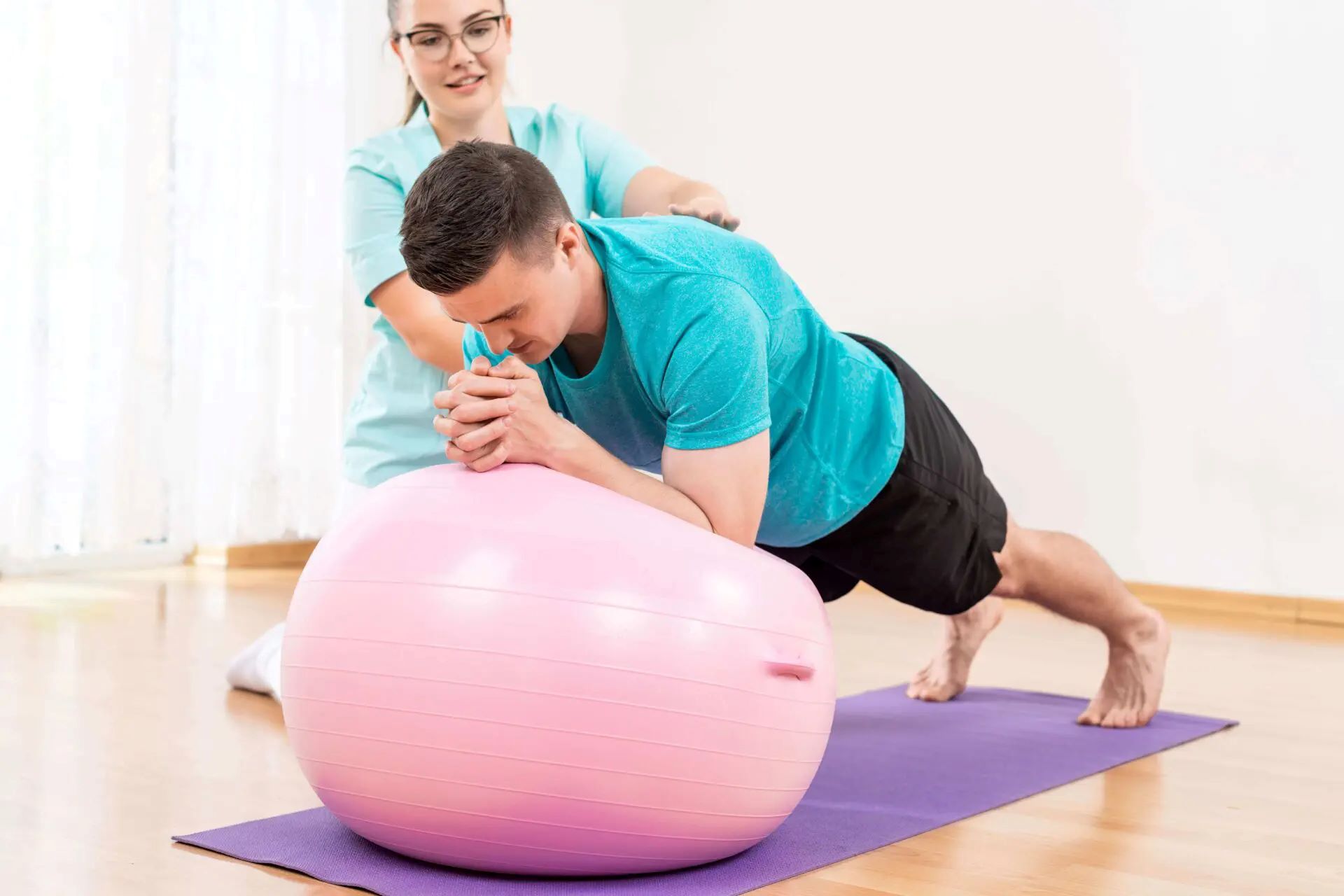Home>Misc>Featured>What Is Abdominal Strength And Endurance?


Featured
What Is Abdominal Strength And Endurance?
Modified: January 2, 2024
Learn what abdominal strength and endurance is and how it can improve your overall fitness. Explore our featured articles on building a strong core.
Introduction
Welcome to the world of abdominal strength and endurance! If you’re looking to sculpt those enviable six-pack abs or simply improve your overall core strength, you’ve come to the right place. Your abdominal muscles play a crucial role in stabilizing your torso, supporting your spine, and maintaining proper posture.
Abdominal strength refers to the ability of your core muscles to generate force and exert control. On the other hand, abdominal endurance is the ability to sustain that strength over a prolonged period of time. Both elements are interconnected and vital for optimal performance in various physical activities, from sports to everyday tasks.
Building and maintaining abdominal strength and endurance not only enhances your athletic performance but also offers a range of benefits for your overall well-being. Strong abdominal muscles improve your posture, reduce the risk of back pain and injuries, and increase your stability and balance.
In this article, we will delve into the world of abdominal strength and endurance, exploring the definition, importance, benefits, measurement methods, effective exercises, and common mistakes to avoid. Whether you’re a fitness enthusiast, an athlete, or someone simply looking to improve core strength, this guide will provide you with valuable insights and practical tips to achieve your goals.
So, let’s get started on this journey to a stronger, healthier, and more resilient core!
Definition of Abdominal Strength
Abdominal strength refers to the level of muscular power and control exhibited by the muscles in your core region, specifically the muscles in your abdomen. These muscles include the rectus abdominis (the “six-pack” muscles), external and internal obliques, and transversus abdominis.
When we talk about abdominal strength, it’s important to understand that it goes beyond just having a chiseled appearance. While a well-defined six-pack may be aesthetically pleasing, true abdominal strength involves the ability of the muscles to generate force and stabilize the torso.
Strength in the abdominal muscles is crucial for maintaining overall core stability and promoting optimal movement patterns. Strong abs help to support the spine, maintain good posture, and transfer force effectively throughout the body. This core stability is essential for various activities, including sports performance, weightlifting, and even day-to-day tasks like bending, lifting, and twisting.
To improve abdominal strength, it’s necessary to target all the different muscle groups in the core. This includes the rectus abdominis, which helps to flex the trunk and move the ribcage towards the hips, as well as the obliques, which assist in rotational movements of the spine. Additionally, the transversus abdominis, which acts as a deep stabilizing muscle, plays a key role in maintaining core integrity.
Having good abdominal strength not only allows for better performance in physical activities but also helps to prevent injuries. Weak abdominal muscles can lead to poor posture, increased strain on the lower back, and decreased stability, which can ultimately result in pain and discomfort in daily life.
Overall, abdominal strength is about developing the capacity to generate force, maintain stability, and support your spine. By working on improving your core strength, you lay the foundation for better athletic performance, improved posture, and a reduced risk of injury.
Importance of Abdominal Strength and Endurance
Having strong abdominal muscles and good endurance in this area is essential for various reasons. Let’s dive into the importance of developing and maintaining abdominal strength and endurance:
- Core Stability: The core muscles, including the abdominals, provide the foundation for all movements. They help stabilize the spine, maintain proper posture, and transfer force effectively throughout the body. A stable core enhances your overall body strength and allows for better performance in sports and everyday activities.
- Injury Prevention: Strong abdominal muscles act as a protective shield for your lower back and spine. They help support and stabilize the entire torso, reducing the risk of back injuries and promoting better alignment during movement. Additionally, having strong abs can prevent muscle imbalances, which can lead to poor movement mechanics and increased risk of injury.
- Improved Athletic Performance: Whether you’re an athlete or a fitness enthusiast, having a strong core is crucial for optimal performance. Power generation in many sports movements involves the transfer of force from the lower body to the upper body and vice versa. Strong abdominal muscles aid in this force transmission and enhance overall athletic performance.
- Better Posture: Weak abdominal muscles can contribute to poor posture, including rounded shoulders and excessive curvature of the spine. Strengthening the core helps to improve postural alignment, reducing the risk of developing chronic pain, muscle imbalances, and postural-related issues.
- Enhanced Balance and Stability: Your abdominal muscles play a significant role in maintaining balance and stability, especially during movements that require shifts in body weight. By having a strong core, you’ll have better control over your body’s equilibrium, reducing the likelihood of falls and improving overall stability in various activities.
- Functional Movement: Strong abdominal muscles are essential for everyday activities, such as lifting heavy objects, carrying groceries, and performing household chores. With a solid core foundation, you’ll have improved functional movement patterns and increased efficiency in these daily tasks.
Overall, developing and maintaining abdominal strength and endurance offers numerous benefits for both physical performance and overall well-being. It improves core stability, reduces the risk of injuries, enhances athletic performance, promotes better posture, increases balance and stability, and enhances functional movement in daily activities. As a result, prioritizing abdominal strength and endurance in your fitness routine is a wise investment in your overall health and fitness.
Benefits of Having Strong Abdominal Muscles
Strong abdominal muscles offer a host of benefits beyond just a toned midsection. Let’s explore some of the key advantages of having a strong core:
- Improved Functional Performance: Strong abdominal muscles enhance your ability to perform everyday tasks with ease. Whether it’s lifting heavy objects, carrying groceries, or even sitting and standing up from a chair, a strong core provides the stability and strength needed to execute these movements effectively.
- Enhanced Athletic Performance: Athletes across various sports rely on a strong core for optimal performance. From generating explosive power in sprinting and jumping to maintaining balance and stability in activities like yoga or surfing, strong abdominal muscles facilitate efficient movement and enhance overall athletic performance.
- Reduced Risk of Back Pain and Injuries: Weak abdominal muscles can lead to increased stress on the lower back, resulting in pain and potential injuries. Strong abs provide support and stability to the spine, reducing the risk of back pain and promoting a healthy posture.
- Better Posture: Strong abdominal muscles contribute to good posture by supporting the spine and promoting proper alignment. Improved posture not only enhances your physical appearance but also helps prevent muscle imbalances and reduces the likelihood of developing chronic pain or postural-related issues.
- Increased Core Stability: Your core serves as a central link between your upper and lower body, providing stability for all movements. A strong core, including the abdominal muscles, enhances core stability, helping you maintain balance and control during physical activities, leading to better overall movement patterns.
- Improved Breathing and Digestion: Your diaphragm, a key muscle involved in breathing, connects to the abdominal muscles. Strong abs can improve the efficiency of your diaphragm, facilitating better breathing patterns. Additionally, strong abdominal muscles can support healthy digestion by promoting proper abdominal pressure and movement of the digestive organs.
- Boosted Confidence and Body Image: Having a well-defined, strong core can boost your self-confidence and body image. The visible results of your hard work can make you feel more confident in your appearance, leading to a positive self-image and improved self-esteem.
By prioritizing the development and maintenance of strong abdominal muscles, you can experience a range of benefits, including improved functional performance, enhanced athletic abilities, reduced risk of back pain and injuries, better posture, increased core stability, improved breathing and digestion, as well as boosted confidence and body image. So, start incorporating core-strengthening exercises into your fitness routine and unlock the advantages of a strong and resilient midsection.
Different Ways to Measure Abdominal Strength
There are several methods to assess abdominal strength and track your progress towards a stronger core. Let’s explore some commonly used ways to measure abdominal strength:
- Plank Test: The plank is a popular exercise that targets the core muscles, including the abs. Timing how long you can hold a proper plank position can serve as a measure of your abdominal endurance. Aim to increase your plank time gradually to build greater abdominal strength.
- Flexibility Tests: Flexibility in the abdominal muscles can indicate their strength and function. Assessments such as the sit-and-reach test or trunk rotation tests can provide insights into the flexibility and range of motion of your core muscles, which are closely tied to their strength.
- Abdominal Strength Machines: In some fitness facilities, there are specialized machines designed to measure abdominal strength. These machines typically involve resistance or weight-based exercises targeting the abs and provide objective data on the strength and power generated by your core muscles.
- Bodyweight Exercises: Exercises such as crunches, bicycles, and leg raises can be used as a subjective measure of abdominal strength. Tracking the number of repetitions or the level of difficulty you can perform with proper form can give you an indication of your current strength level.
- Functional Movement Assessment: Observing how well your core muscles support and stabilize your body during functional movements can provide insights into your abdominal strength. Movements like squatting, lunging, throwing, or twisting can be assessed by a fitness professional to gauge the effectiveness of your core activation and stability.
- Electromyography (EMG): EMG is a technology that measures muscle activation by detecting electrical signals. This method can be used to assess the activity and recruitment of the abdominal muscles during specific exercises, providing a more objective measure of abdominal strength.
It’s important to note that while these methods can be useful in evaluating abdominal strength, they may not provide a comprehensive assessment. Abdominal strength encompasses more than just specific exercises or movements. It’s a combination of multiple factors, including muscle endurance, stability, and recruitment patterns.
Consider consulting with a knowledgeable fitness professional who can guide you through proper assessments and recommend personalized exercises to target your specific abdominal strength goals. By using a combination of objective and subjective measures, you can track your progress and continually strive for improved abdominal strength and endurance.
Exercises to Improve Abdominal Strength and Endurance
To enhance abdominal strength and endurance, incorporating targeted exercises into your fitness routine is essential. Here are some effective exercises that will help you strengthen and develop your core muscles:
- Plank: The plank is a foundational exercise that engages multiple core muscles simultaneously. Start by assuming a push-up position and hold your body in a straight line from head to toe, engaging your abs and glutes. Aim to hold the plank for 30 seconds to start and gradually increase the duration as your strength improves.
- Crunches: Crunches specifically target the rectus abdominis, the “six-pack” muscles. Lie on your back with your knees bent and feet flat on the floor. Lift your upper body off the ground, engaging your abs, and lower back down slowly. Perform controlled repetitions, focusing on the contraction and relaxation of the abdominal muscles.
- Russian Twists: Sit on the floor with your knees bent and feet lifted. Hold a weight or medicine ball in front of your chest and rotate your torso from side to side, tapping the weight on the floor on each side. This exercise targets the oblique muscles, improving rotational strength and stability.
- Bicycle Crunches: Lie on your back with your hands behind your head and legs raised. Alternate bringing your right elbow towards your left knee while extending your right leg, then switch to bring your left elbow towards your right knee. This exercise engages both the upper and lower abdominal muscles, as well as the obliques.
- Leg Raises: Lie on your back with your legs straight and your hands resting by your sides. Lift your legs off the ground, keeping them together and engaging your lower abs. Slowly lower your legs back down towards the floor without letting them touch the ground, then repeat. This exercise targets the lower abdominal muscles.
- Mountain Climbers: Start in a high plank position and bring one knee towards your chest while keeping the other leg extended. Alternate the movement, switching between legs in a running motion. Mountain climbers engage the entire core and provide a cardiovascular challenge, making them great for both strength and endurance.
- Flutter Kicks: Lie on your back with your legs extended and your hands by your sides. Lift your legs slightly off the ground and alternate kicking them up and down in small, controlled motions. Flutter kicks engage the lower abdominal muscles and are a great exercise for endurance and toning.
Remember, proper form and technique are crucial for maximizing the effectiveness of these exercises and preventing injury. Start with a weight or resistance level that challenges you without compromising your form. As you progress, gradually increase the intensity, duration, or resistance to continue challenging your abdominal muscles.
It’s also important to vary your routine by incorporating different exercises and workout formats to target all areas of your core. This variation helps to engage all the different muscles within the abdominal region and prevent plateauing in your progress.
Always listen to your body and modify or remove any exercise that causes discomfort or pain. If you have any pre-existing medical conditions or concerns, consult with a fitness professional or healthcare provider for personalized guidance and recommendations.
With consistency and dedication, these exercises will help you improve both the strength and endurance of your abdominal muscles, leading to a stronger and more functional core.
Common Mistakes to Avoid While Working on Abdominal Muscles
When it comes to working on your abdominal muscles, it’s important to be mindful of proper form and technique to maximize effectiveness and prevent injury. Avoiding these common mistakes will help you get the most out of your abdominal workouts:
- Relying Solely on Crunches: While crunches can be effective for targeting the rectus abdominis, solely relying on this exercise can neglect other core muscle groups. Incorporate a variety of exercises that engage the entire core, including the obliques, transversus abdominis, and lower back muscles.
- Using Momentum: One of the most common mistakes during abdominal exercises is relying on momentum rather than muscle control. Avoid using swinging or jerking movements to perform the exercises. Instead, concentrate on engaging your abdominals and moving with control throughout the entire range of motion.
- Neglecting Breathing: Breathing properly during abdominal exercises is crucial. Avoid holding your breath during the movements, as it can lead to increased tension and make it harder to engage the muscles effectively. Inhale through your nose and exhale through your mouth, coordinating your breath with the contraction and relaxation of your abdominal muscles.
- Overtraining: Giving your abdominal muscles time to recover is just as important as the actual exercise. Overtraining can lead to muscle fatigue, reduced performance, and increased risk of injury. Allow at least 48 hours of rest between intense abdominal workouts to allow for adequate recovery.
- Ignoring Proper Posture: Maintaining proper posture throughout abdominal exercises is crucial for targeting the intended muscles and preventing strain on other areas. Keep your spine neutral, shoulders relaxed, and engage your core by drawing your belly button towards your spine. Avoid arching your back or rounding your shoulders.
- Focusing Only on the Front: The core is 360 degrees, and neglecting the muscles at the back can lead to imbalances and potential injuries. Include exercises that target the lower back, such as Superman, bird dogs, and back extensions, to maintain overall core strength and stability.
- Not Progressing or Challenging Yourself: To continue making progress, it’s important to gradually increase the intensity of your abdominal workouts. Challenge yourself by adding resistance, increasing the number of repetitions, or trying advanced variations of the exercises. This will ensure ongoing improvements in strength and endurance.
Taking the time to learn and practice proper form is paramount when it comes to abdominal exercises. Focus on quality over quantity, and aim for controlled movements that engage the targeted muscles fully. Remember, it’s better to perform fewer repetitions with good form than to rush through exercises with poor form.
Consider seeking guidance from a qualified fitness professional who can provide proper instruction, corrections, and progressions tailored to your specific needs and goals. They can help you avoid these common mistakes and create a safe and effective abdominal workout routine.
By being mindful of these common mistakes and practicing proper technique, you can optimize the effectiveness of your abdominal workouts and minimize the risk of injury, paving the way for stronger and healthier core muscles.
Tips for Maintaining Abdominal Strength and Endurance
Building abdominal strength and endurance is a continuous journey that requires consistency and dedication. To maintain your hard-earned gains and continue progressing, consider the following tips:
- Consistent Core Training: Make sure to include regular core training sessions in your fitness routine. Aim for two to three dedicated sessions per week that focus on strengthening and conditioning your abdominal muscles. Consistency is key to maintaining and improving your abdominal strength and endurance.
- Varied Exercises: Keep your abdominal workouts challenging and engaging by incorporating a variety of exercises. Target not only the front of your core but also the sides and back. Mix up your routine with different planks, crunches, twists, and functional movements to fully engage all the muscles in the abdominal area.
- Progressive Overload: Continually challenge your abdominal muscles by progressively increasing the difficulty of your workouts. This can be done by adding resistance, increasing the duration or intensity of exercises, or trying more advanced variations. Gradually increasing the demands on your muscles will help them adapt and grow stronger.
- Cardiovascular Exercise: Incorporate cardiovascular exercise into your routine to improve overall endurance, including endurance in your abdominal muscles. Activities like running, swimming, cycling, or HIIT workouts can boost your cardiovascular fitness and indirectly contribute to improved abdominal endurance.
- Mind-Body Connection: Focus on developing a strong mind-body connection during your workouts. Concentrate on engaging and activating your abdominal muscles with each exercise. Visualize the muscles working and contracting, and maintain proper form and control throughout each movement.
- Proper Nutrition: A balanced diet plays a crucial role in supporting muscle growth and recovery. Ensure you are consuming sufficient protein to aid in muscle repair and growth. Fuel your body with whole foods, lean proteins, healthy fats, and plenty of fruits and vegetables to provide the necessary nutrients for optimal muscle function.
- Rest and Recovery: Allow your body ample time for rest and recovery between workouts. Get enough sleep to promote muscle repair and growth. Additionally, listen to your body and give yourself a break when needed. Avoid overtraining, as it can lead to fatigue and hinder progress.
- Postural Awareness: Be mindful of your posture throughout the day, not just during exercise. Practice maintaining proper alignment and engaging your core muscles during daily activities. This can help enhance core strength, improve posture, and prevent strain on the lower back.
Remember, consistency and patience are key when it comes to maintaining abdominal strength and endurance. Celebrate your progress and stay motivated by setting realistic goals and tracking your improvements over time. By incorporating these tips into your fitness routine, you will maintain a strong and resilient core that supports you in various activities and contributes to your overall health and well-being.
Conclusion
Developing and maintaining strong abdominal strength and endurance is a worthwhile investment in your overall fitness and well-being. Strong abs not only contribute to a toned and sculpted midsection but also provide a solid foundation for optimal performance in various physical activities, improved posture, reduced risk of injuries, and increased stability and balance.
In this article, we explored the definition of abdominal strength and the importance of developing and maintaining strong core muscles. We discussed the benefits of having strong abdominal muscles, such as improved functional performance, enhanced athletic abilities, reduced risk of back pain, and increased confidence.
We also delved into different ways to measure abdominal strength, including plank tests, flexibility assessments, abdominal strength machines, and functional movement evaluations. These measurement methods can help track your progress and provide valuable feedback on your abdominal strength journey.
To improve abdominal strength and endurance, we discussed several effective exercises, such as planks, crunches, Russian twists, and leg raises. By incorporating these exercises and ensuring proper form and technique, you can target all areas of your core and progress towards a stronger and more functional midsection.
We also highlighted common mistakes to avoid, such as relying solely on crunches, using momentum, neglecting breathing, and overtraining. By being mindful of these mistakes and practicing proper techniques, you can optimize the effectiveness of your abdominal workouts and minimize the risk of injury.
To maintain your abdominal strength and endurance, we provided tips including consistent core training, varied exercises, progressive overload, cardiovascular exercise, mind-body connection, proper nutrition, rest and recovery, and maintaining postural awareness. By following these tips, you can continue to progress and sustain your hard-earned gains.
In conclusion, developing and maintaining abdominal strength and endurance requires commitment, consistency, and the right approach. By incorporating proper techniques, challenging exercises, and a balanced lifestyle, you can enjoy the benefits of a strong and resilient core that supports you in all aspects of life.









